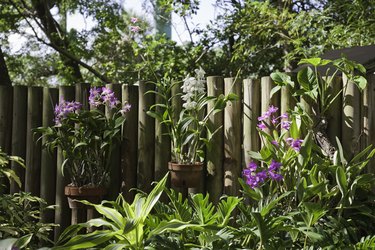
In addition to water and sunlight, plants need certain nutrients to become healthy. One of these nutrients is nitrogen. Found in the soil on which plants grow, nitrogen is an essential element in plant growth, and too little or too much of it can yield potentially devastating results, usually sad, wilted leaves and stunted growth. Fortunately, sources of nitrogen are easy to come by and can deliver immediate results when used correctly.
Why Do Plants Need Nitrogen?
Video of the Day
Nitrogen plays an important role in the health and growth of all plants, and it is responsible for the green leaves you see growing on them. Nitrogen helps plants photosynthesize, which is a process that involves using energy from the sun to break down water and carbon dioxide so that sugars are formed. These sugars are then used as food for the plant, and the byproduct of the process is oxygen.
Video of the Day
Nitrogen is also one of the main components of amino acids, which form the proteins that plants need to stay alive. Too little nitrogen often results in withered leaves that are usually yellow in color, which is symptomatic of slow photosynthesis rates, while too much nitrogen can prevent other essential nutrients from being absorbed by the plant. This is why maintaining just the right balance of nitrogen is an essential part of growing a healthy plant.
Where Do Plants Get Nitrogen?
The nitrogen that plants require is found in the soil on which the plant grows. The level of nitrogen found within that soil, however, will depend on the condition of the soil. This can be affected by the quality, temperature and moisture found within the atmosphere around the soil, which includes the air.
Because nitrogen aids in the process of photosynthesis, giving your plants access to nitrogen is essentially like giving them access to food. The more they get (within reason, of course), the bigger and stronger they can grow. Some plants, like roses, squash and tomatoes, to name a few, require more nitrogen than the average plant and may need an added boost to have their needs met.
How to Use Nitrogen
So, what can you do if you wish to raise healthy plants but you don't have much nitrogen in the soil with which you're working? Luckily, you can simply add as much or as little as you need, which can be delivered through a variety of easy and cost-effective methods. The first way you can add nitrogen to the soil is to add animal or plant byproducts, including crab meal, cottonseed meal, and composted manure from animals such as cows and chickens. If plant-based solutions are more to your liking, you can try alfalfa meal, which is an effective nitrogen and phosphorus fertilizer, or soybean meal, which is often used to promote growth on lawns.
When adding nitrogen to the soil, you can also visit your local garden supply store for bagged fertilizer that contains the nutrient. Types of fertilizer include quick- or slow-release granular fertilizer, liquid fertilizer and plant food spikes, the latter of which is a way to fertilize potted indoor plants over time. When shopping, it's important to understand the fertilizer elements contained within the bag, which are represented by three numbers separated by dashes. These explain the percentages of nitrogen, phosphorus and potassium, in that order, that are contained within the fertilizer. For example, a bag reading 16-4-8 contains 16 percent nitrogen.